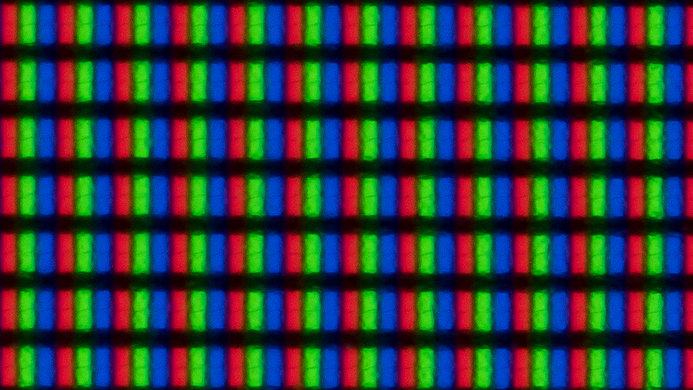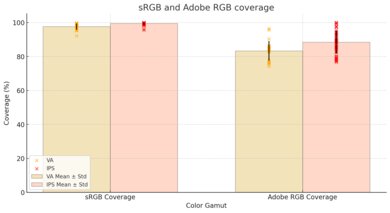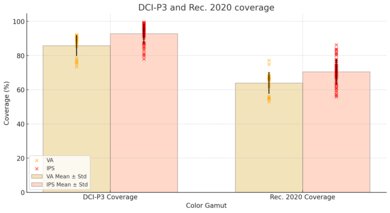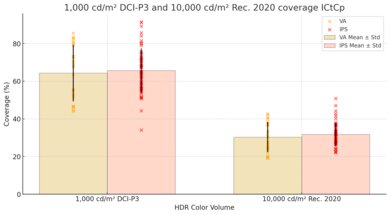The majority of LED-backlit LCD monitors are made with one of two common panel types: IPS or VA. These displays share the same basic structure with LED lights placed behind the LCD panel. Each panel type has red, green, and blue subpixels that shift to let light pass through, producing a viewable image. That said, the differences between VA and IPS panels mainly come down to the way their subpixels move. Although this may seem small, this results in differences in picture quality and performance.
When comparing VA vs IPS monitors, you should know that IPS monitors have wider viewing angles, while VA monitors have a better contrast ratio. There are some other factors that you may want to consider, like the fact that IPS monitors generally have better motion handling and more, but these also vary between units.
Below, we'll cover the main differences between the two panel types and how they impact your monitor's performance.
You can also learn about IPS vs VA TVs, and you can also read our articles on What Is VA and What Is IPS if you want more technical details on each. If you want to learn about other panel types, check out our LED vs OLED, OLED vs IPS, or IPS vs TN articles.
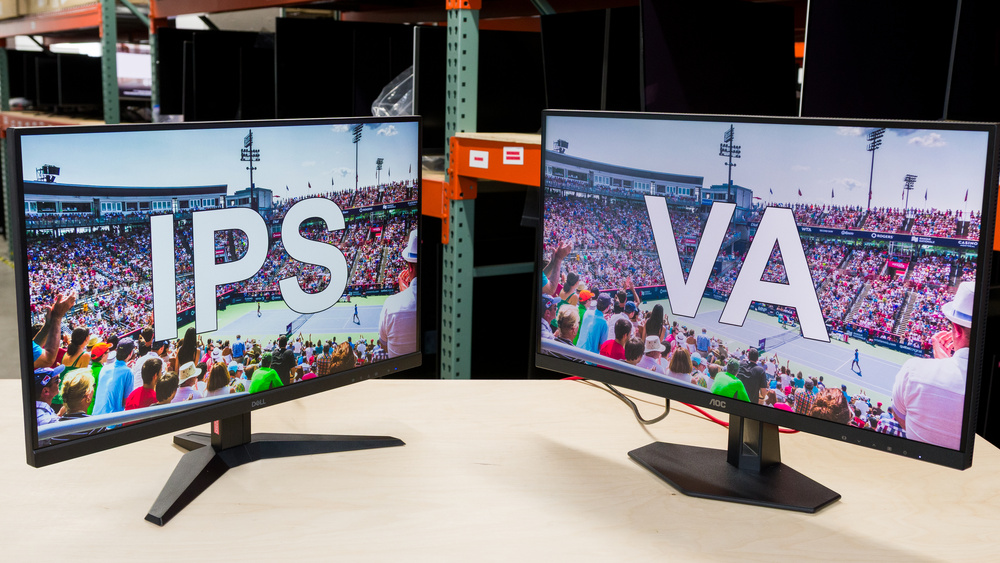
Technical Differences
In-Plane Switching (IPS) and Vertical Alignment (VA) panels are two of the most common LCD panel types found in monitors. Various manufacturers make different subtypes of IPS and VA panels, but what categorizes either of these panel types is how the pixels move when light passes through.
In an IPS panel, the subpixels are aligned horizontally and rotate parallel to the monitor's glass substrate to let light pass through. In other words, the pixels rotate like the hands of a clock would in your watch. On the other hand, VA subpixels are aligned vertically and rotate perpendicular to the glass substrate, similar to shutter blinds. This blocks more light than IPS pixels, resulting in deep blacks.
Below are examples of the subpixels on various IPS and VA panels. You can see that there's a variation in the shape of the subpixels of IPS panels, while most VA panels generally look more or less the same.
What's Better: IPS or VA?
The battle of VA vs IPS doesn't have a true winner, as choosing one over the other really depends on your needs. That said, there are certain areas in which IPS panels are better, and others in which VAs are better. Generally speaking, you should get an IPS monitor if you want wide viewing angles, like for work or co-op gaming, as this is their greatest strength. VA panels have better contrast, making them a better choice for use in a dark room.
Below, we're going to compare the main differences between VA vs IPS panels.
Contrast
Winner: VA
Firstly, the biggest advantage of VA panels has to do with their contrast ratio. They generally have higher contrast than any IPS display, allowing them to display deeper blacks next to bright highlights. Although there are IPS Black panels available now that have better contrast than normal IPS panels, they're still behind VA panels. You can see this below with images of checkerboard and black uniformity patterns between IPS, Enhanced IPS Black, and VA monitors.
| IPS | Enhanced IPS Black | VA |
|---|---|---|
| LG 27GP850-B/27GP83B-B | Dell U2725QE | Samsung Smart Monitor M80D S32DM80 |
 |
 |
 |
 |
 |
 |
Viewing Angles
Winner: IPS
While VAs are the winner when it comes to contrast and black levels, IPS panels pull ahead with viewing angles. This means the image remains consistent as you view it from the sides. This helps if you need to share your screen with someone next to you, or if you have it in a multi-monitor setup and you aren't viewing the screen from directly in front. The biggest downside with VA panels is that the image washes out from the sides and loses brightness, so you aren't seeing a consistent image as you move off-center. You can see this difference with the videos of the IPS Acer Nitro XV275K P3biipruzx and the VA Acer Nitro XV275U P3biipx below.
One thing to keep in mind, though, is that not all IPS panels have the same wide viewing angles. This is related to the fact that there are different subtypes of IPS panels, as some are better than others for viewing angles. For example, the ViewSonic XG2431 has color washout at a 48-degree angle of viewing, while the MSI G274QPF-QD washes out after 26 degrees, although they're both IPS panels. That said, even the worst IPS monitors are still better than VA panels for viewing angles.
| IPS | VA |
|---|---|
Colors
Winner: IPS
IPS panels also have a slight advantage when it comes to colors, but this is something that also varies between units: you can have a VA panel with better colors than another IPS monitor. That said, using data from 84 monitors that we tested on Test Benches 2.0.1 and 2.1, we see that the average color gamut coverage of the IPS monitors we've tested is better than the average of the VA monitors. This applies to any color gamut, from the basic sRGB color space used in most web content to the wider Rec. 2020 color space used in HDR content.
The color gamut defines the range of colors a monitor displays at a certain brightness level, while the color volume is the range of colors it displays at any brightness level. Interestingly, VA panels are closer to IPS for HDR color volume than the color gamut, mainly because they display dark colors better due to their higher contrast.
Below, you can see graphs showing the average coverage and spread of the color gamut and volume of 61 IPS monitors and 23 VA monitors that we tested. While the average favors IPS monitors, you can also see that there's a large spread for each color gamut besides the sRGB color space, so getting an IPS monitor doesn't guarantee good colors. Besides that, color accuracy is something that the panel type doesn't affect and varies between units.
Motion
Winner: IPS
Motion handling is another aspect that generally favors IPS monitors, but varies between units. This means that there are VA monitors with better motion handling than IPS displays. That said, the biggest downside of gaming with VA panels is that they have black smearing. This is because they have slow response times when transitioning from bright colors to darker ones, and vice versa, which results in black trails behind fast-moving objects. Even the best VA panels have this issue, which doesn't occur with IPS monitors.
Below you can see examples of VA and IPS monitors and how they handle motion at their max refresh rates of 180Hz. The VA monitors actually have very fast response times, with the AOC having one of the fastest average Total Response Time that we've tested on any LED monitor at the time of writing this article. However, it's much slower when transitioning from dark colors to bright ones, or from bright to dark. This is why it has a slower Worst 10% Total Response Time (the average of the seven worst response time transitions), and this is what causes black smearing behind objects. You can see this with the purple TV against the green background in the bottom left of the pursuit photo.
While the IPS monitors have slower average response times, they don't have this smearing with fast-moving objects. You can also see that not all IPS monitors have better motion handling than VA monitors, as the Samsung in the example below has an IPS panel, but the slowest average total response time, leading to blur.
| VA | IPS | ||
|---|---|---|---|
| AOC Q27G3XMN | Dell Alienware AW3425DWM | LG 27GP850-B/27GP83B-B | Samsung Odyssey G50D S27DG50 |
 Worst 10% Total Response Time: 10.3 ms |
 Worst 10% Total Response Time: 10.9 ms |
 Worst 10% Total Response Time: 9.7 ms |
 Worst 10% Total Response Time: 12.5 ms |
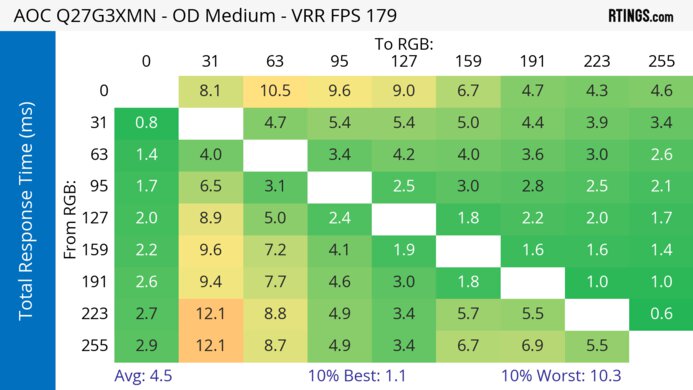 |
 |
 |
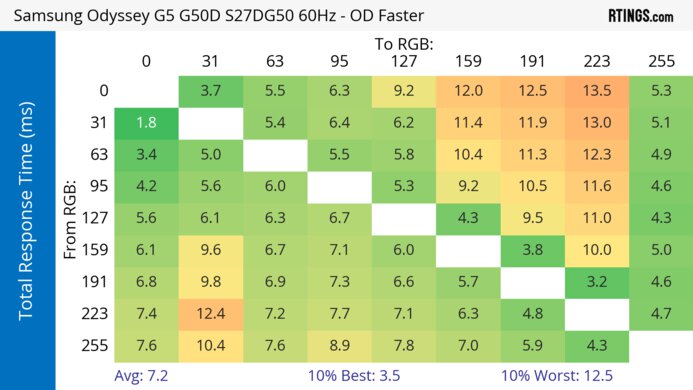 |
VRR Flicker
Besides the black smearing, another downside of VA panels that may negatively impact your gaming experience is with VRR flicker. This happens when you have VRR enabled on the monitor and there's a big change in the frame rate, like a loading menu, and it's mostly distracting in dark scenes. It's a common downside of VA monitors, which are generally worse than IPS panels for this. Although some IPS monitors still have flicker, these are rare, and generally, the flicker isn't as bad as on VA monitors.
Below, you can see the difference in VRR flicker with IPS and VA monitors using the same test scene.
| VA | IPS |
|---|---|
| AOC Q27G3XMN | LG 27GR95UM-B |
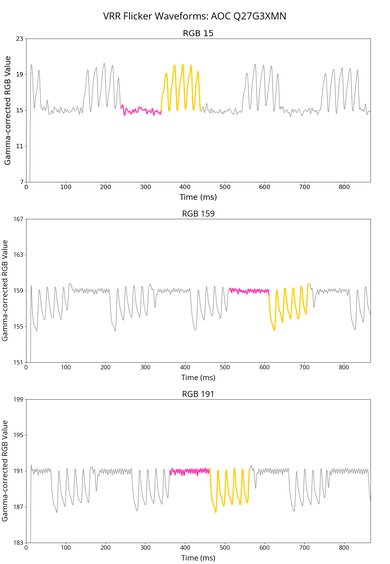 |
 |
Frequently Asked Questions
Is the input lag different between VA and IPS monitors?
No, the input lag is a processing-related aspect of a monitor's performance, and the panel type has no impact.
Are IPS monitors brighter than VA monitors?
There's no general difference in brightness between IPS and VA monitors. The brightest monitors use Mini LED backlighting, but there are Mini LED monitors with VA and IPS panels. On a similar note, neither panel type is the winner when it comes to reflection handling, as that ultimately comes down to the monitor's screen coating.
Does one panel type cost less than the other?
No. There are a wide range of models with IPS and VA panels, meaning you can find both entry-level and premium monitors with either panel type. Neither is cheaper than the other, but if you're on a tight budget, you can also check out our recommendations for the best monitors under $200.
Which panel type has better text clarity?
There are multiple factors that impact the text clarity, but the panel type isn't one of them. Instead, the size, resolution, and screen coating all impact how sharp text looks. However, panels with non-RGB subpixel layouts, like the BGR subpixel layout of the IPS panel on the Gigabyte M27Q (rev. 1.0), have worse text clarity.
Do LCD panels risk burn-in?
Unlike OLED displays, LCD displays, whether they're IPS or VA, don't risk burn-in with constant exposure to the same static elements over time. This means you can get an IPS or VA monitor for work and not worry about damaging the screen.
Conclusion
IPS and VA panels are the two most common LCD panel types in the monitor market, and there's a wide range of options available with each type. While the LCD panel type doesn't impact factors like brightness, color accuracy, text clarity, and cost, there are a few areas in which IPS and VA monitors have their pros and cons. IPS monitors have wider viewing angles and tend to have better motion handling with less smearing, so you should consider them for work or gaming with fast-moving objects. On the other hand, VA panels have a higher contrast ratio for deeper blacks, which makes them better choices for use in a dark room. That said, there are multiple factors you should think about before buying a monitor, and deciding between VA vs IPS panels should only be one of your decisions, but not the ultimate one.
